MS-4 june-2007
MS-4 - june-2007
MS-4 : ACCOUNTING AND FINANCE FOR MANAGERS
1. (a) Explain the Continuity concept and the Periodicity concept and discuss their significance.
(b) Explain the nature of accounting function and describe the role played by the Accountant in a business organisation.
2. The following items appear on the Trial Balance prepared from the books of Mr. Kamal Saxena as on 31st March 2006 after making necessary adjustments for depreciation on fixed assets, outstanding and accrued items and placing the difference under Suspense Account.
Machinery: 1,70,000
Furniture: 49,500
Sundry Debtors: 38,000
Drawings: 28,000
Travelling Expenses: 6,500
Insurance: 1,500
Audit Fees: 1,000
Salaries: 49,000
Rent: 5,000
Cash in hand: 7,800
Cash at Bank: 18,500
Stock in trade (1-4-2005): 80,000
Prepaid Insurance: 250
Miscellaneous expenses: 21,200
Suspense A/c (Dr.): 39,400
Sundry Creditors: 82,000
Capital Account: 2,45,750
Outstanding Expenses :
Salaries: 1,500
Printing: 600
Audit Fees: 1,000
Bank Interest (Cr.): 1,200
Discounts (Cr.): 1,800
Sales less Refurns): 6,80,00
Discount allowed: 1,200
Printing and Stationery: 1,500
Purchases (less Returns): 4,60,00
Depreciation :
Machinery: 30,000
Furniture: 5,500
On a subsequent scrutiny the following mistakes were noticed
(i) A new machinery was purchased for Rs. 50,000 but the amount was wrongly posted to Furniture Account as Rs. 5,000.
(ii) Cash received from Debtors Rs. 5,600 was omitted to be posted in the ledger.
(iii) Goods worth Rs. s,000 withdrawn by the proprietor for personal use, but no entry was passed.
You are further told that :
(a) Closing Stock amounted to Rs. 47,500.
(b) Depreciation on Machinery and Furniture has been provided @ 15% and 10% respectively On declining balance system. Full year's depreciation is provided on addition.
You are required to prepare a Trading and Profit and Loss Account for the year ended on 31st March 2006 and a Balance Sheet as on that date.
3. (a) Explain the concept of cost of capital as a device for establishing a cut-off point for capital investment proposals.
(b) Discuss the limiting factors in the reliability of capital budgeting techniques including the discounted cash flow techniques.
4. (a) What is optimum cash balance ? How can it be determined ? Explain.
(b) Distinguish between Cash Flow Statement and Funds Flow Statement." What purposes do they serve? How do you calculate Funds from Business Operations while preparing a Funds Flow Statement? Explain.
5. (a) Explain the three important control ratios that are used to compare the actual performance with the budgeted performance.
(b) Distinguish between Fixed Budget and Flexible Budget. When is a Flexible Budget considered desirable ? Explain.
6. A company produces a single product which is sold by it presently in the domestic market at Rs. 75 per unit. The present production and sales is 40,000 units per month representing 50% of the available capacity. The cost data of the product are as under:
Variable cost per unit Rs. 50.
Fixed cost per month Rs. 10 lakh.
To improve profitability, the management has 3 proposals on hand as under :
(a) To accept an export supply order For 30,000 units per Month at a reduced price of Rs. 60 per unit, incurring additional variable costs of Rs. 5 per unit towards export packing, duties etc.
(b) To increase the domestic market sales by selling to a domestic chain store 30,000 units at Rs. 55 per unit, retaining the existing sales at the existing price.
(c) To reduce the selling price for the increased domestic sales as advised by the sales department as under :
|
Reduce Selling price |
Increase in Sales |
|
5 |
10,000 |
|
8 |
30,000 |
|
11 |
35,000 |
Prepare a table to present the results of the above proposals and give your comments and advice on the proposals.
7. Comment on the following statements :
(a) Operating cycle plays a decisive role in influencing the working capital needs.
(b) "Debt is a double-edged knife."
(c) Break -even analysis is not without limitations.
(d) Higher profit margin need not necessarily lead to higher rate of return on investment.
(e) A company's profitability is better judged by PBIT rather than by PAT.
8. Write short notes on the following :
(a) Absorption Costing
(b) Zero based Budgeting
(c) Direct Labour Variances
(d) Sunk Costs and Imputed Costs
MS-4 june-2008
MS-4 - june-2008
MS-4 : ACCOUNTING AND FINANCE FOR MANAGERS
l. (a) What do you understand by the concept of conservatism ? Why is it also called the concept of prudence ? Why is it not applied as strongly today as it used to be in the Past ?
(b) What is a Balance Sheet ? How does a Funds Flow Statement differ from a Balance Sheet ? Enumerate the items which are usually shown in a Balance Sheet and a Funds Flow Statement'
2. (a) Why does depreciation need to be provided on fixed assets and what are the usual methods of providing depreciation
(b) Discuss the role of the Board of Directors in dividend decision
3. What do you understand by Discounted Cash Flow Techniques of Capital Budgeting ? Briefly explain the Net Present Value Method and Internal Rate of Return Method. which of the two would you rank better and why ?
4. Distinguish between :
(a) Financial Leverage and operating Leverage
(b) Cash Budget and Cash Flow Statement
c) FIFO AND LIFO
(d) Preference shares and Rights shares
A company manufactures a single product in its factory utilising 60% of its capacity. The details are given below :
Rs
Sales (6,000 units) 540000
Direct materials 96000
Direct labour 120000
Direct expenses 18000
Fixed overheads :
Factory 200000
Administration 21000
Selling and Distribution 25000
12.5 % of factory overheads and 20% of selling and distribution overheads are variable with production and sales. Administrative overheads are wholly fixed. Since the existing product could not achieve budgeted level for two consecutive years, the Company decides to introduce a new product with marginal investment but largely using the existing plant and machinery.
The cost estimates of the new product are as follows :
Cost elements Rs. per unit
Direct materials 16
Direct labour 15
Direct expenses 1.5
Variable factory overheads 2.0
Variable selling and distribution overheads 1.50
It is expected that 2,000 units of the new product can be sold at a price of Rs. 60 per unit. The fixed factory overheads are expected to increase by t}o/o, while fixed
selling and distribution expenses will go up by Rs. 12,500 annually. Administrative overheads remain unchanged.
However, there will be an increase of working capital to the extent of Rs. 75,000, which would take the total cost of the project to Rs. 8.75 lakh
The company considers that 20% pre-tax and interest return on investment is the minimum acceptable to justify any new investment.
You are required to
(a) Decide whether the new product be introduced.
(b) Make any further observations /recommendations
about profitability of the company on the basis of
the above data after making assumption that the present investment is Rs. 8 lakh.
6- Explain fully the following statements :
(a) "Lower the Break-even point, better it is
(b) "Greater the variability of cash flows, higher should be the minimum cash balance
(c) "Weighted average cost of capital would always be higher, if the market value weights are used. "
(d) "Capitalisation of reserves is different from capital resgrves. "
7 Why do you understand by the term 'pay-out ratio' ? What factors are taken into consideration while determining pay-out ratio ? should a company follow a fixed pay-out ratio policy ? Discuss fully.
MS-4 june-2009
MS-4 - june-2009
MS-4 : ACCOUNTING AND FINANCE FOR MANAGERS
1. 'Management Accounting is an extension of financial Accounting'. Explain how is Management Accounting..an effective tool of financial control ? Discuss.
2. Explain the cost concept and the concept of conservation. Why are assets shown at cost even when this market prices far exceeds the cost ? Give reason.
3.Why are Reserves created at the time of preparing the final accounts ? Distinguish
between General Reserve and Specific Reserve and give their examples.
4.Distinguish between capital expenditure and revenue expenditure. what will be the
effect on net profit, if the accountant treats a capital expenditure as revenue expenditure. Discuss.
5. Distinguish between :
(a) Gross Working Capital and Net Working Capital.
b) Current Ratio and Quick Ratio.
c) Direct Labour Rate Variance and Direct. Labour Efficiency Variance.
d) Committed Fixed Costs and Disentionarv Fixed Costs.
6. In what way is financial leverage related to operating leverage ? Discuss with an example.
7. How would you appraise the technical feasibility and financial viabilrty of a project ? Explain.
8.What do you understand by Zero Base Budgeting ? Discuss the steps that are involved in the preparation of Zero Base Budget and describe its advantages over a traditional budget.
9. Explain fully the following statements :
a) very high current ratio is not desirable.
(b) "Cash Budget is a statement of all incomes and expenses during a given period."
(c) "Weighted average cost of capital would always be higher, if the market value weights are used."
(d) Companies with very high profits generally have a low pay out ratio.
10. Following details have been extracted from the annual budget of a manufacturing company for the year 2007 and 2008 :
Particulars Per Unit Rs. Per Annual rs
Selling Price 300
Direct Materials 64
Direct Labor 48
Production overheads:
Variable 32 4000000
Fixed 3000000
Administrative overheads-fixed
Selling and Distribution overheads:
Variable 36
Fixed 20,00,000
Currently the company is operating on a margin of safety of 25%. To improve its
profitability further, the company is considering the following options.
(a) Reduce selling price by 5%. Sales volume is expected to increase by 2A% also fixed production overheads will increase by Rs. 2lakh and fixed selling and distribution over heads by Rs 3 lakh.
b) Increase selling price by 5%. This will cause a drop in sales volume by 10%. To arrest further fall in sales, an increase of Rs 2 lakh will be required under fixed selling and distribution overheads.
c) Production can be increased by 15% by introducing an incentive scheme for labour.
This will be increase direct labour cost by 25%. An additional expenditure of Rs 3lakh would be required under fixed selling and distribution overhead to market the
increased production.
Required :
(a) Current level of production/sales and profit earned.
b) Assuming that (i), (ii) and (iii) above are mutually exclusive and other views remain unchanged, evaluate each of these options.
(c) If the company is able to reduce raw material cost by Rs 5 per unit by making
bulk purchases and reduce the fixed overhead costs by 2 lakh by suitable economy measures, at what selling price per unit should it sell its current production to earn a 10% increase in current profit ?
- The Balance Sheets of ABC Manufacturing Company Ltd. as on December 31, 2007 and 2008 are as follows :
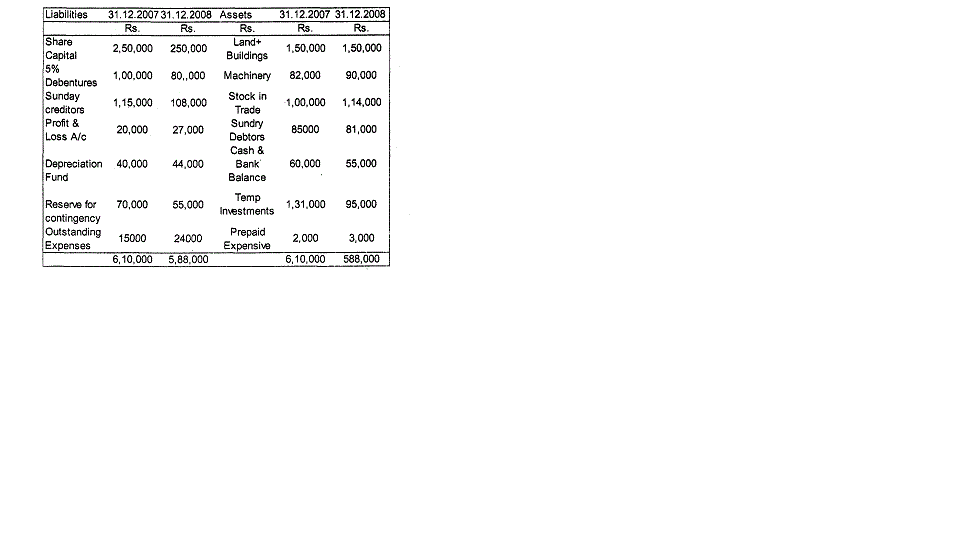
The following additional information is also available.
(a)A new machinery was purchased for Rs. 30,000 and old machinery costing Rs. 15,000 was sold for Rs. 5,000. Accumulated depreciation was Rs. 8,000.
(b) Rs 20,000 5% debentures were reduced by purchase from open market @ Rs 96.
c) Rs 36,000 investments were sold at book value.
d) 12% dividend was paid in cash
e) Rs.15,000 was debited to Contingency Reserve to settlement of previous tax liability.
You are required to prepare :
(a) a statement of changes in Working Capital, and
(b) a statement showing the sources and application of funds.
Ms-4 June 2010
MS-4 june-2010
MS-4 : ACCOUNTING AND FINANCE FOR MANAGERS
1."In managing cash, the finance manager faces the problem of compromising the conflicting goals of liquidity and profitability". Comment on this statement. How would you determine the optimum cash balance in a business organisation ?
2. What is meant by appropriate capital structure ? Discuss the determinants and features
of an appropriate capital structure for a corporate body.
3. (a) How is a statement of changes in working capital prepared for 'Fund FlowAnalysis' ?
(b) How is 'cash from operating activities' calculated in cash flow analysis ?
4. Write notes on :
a) Going concern.
b) Return on investment.
(c) Management Accounting.
(d) Capital rationing.
5. Explain differences between :
a) Prime cost and factory cost.
b) First in, First out and Last in, First out methods of inventory valuation.
c) Fixed budget and flexible budget.
d) Contribution and margin of safety.
6.Discuss the features of accounting information which can be generated from accounting
records. How do different users use this information ?
7(a) Following information is available for a company for January and February 2009.
January February
Sales (Rs.) 38 lakh 65 lakh
Profits (Rs.) - 3 lakh
Loss (Rs.) 2.4 lakh –
Compute : (i) Break even sales volume
ii) Profit or loss at Rs. 46 lakh sales
iii)Sales to earn a profit of Rs. 5 lakh.
(b) Calculate Direct Material Cost Variances Direct Material usage variance and Direct Material Price Variance from the following information :
Finished production
during the period 1000 units
Opening Stock of material 1000 kg.
Closing Stock of material 2000 kg.
Value of material purchased Rs. 1 lakh
Standard rate of material Rs. 20 per kg.
Standard quantity of material
per unit of finished product 2 kg.
Quantity of material purchased 4000 units
8. From the following information draw up a balance sheet :
Gross profit ratio 20%, liquidity ratio : 1.5
Reserve : Share Capital 0.5 : 1
Networking Capital Rs. 30 Lakh.
Current ratio 2.5, fixed asset turnover ratio : 2 times
Average Debt collection period : 2 months,
Stock turnover ratio : 6 times (cost of sales/closing stock)
Fixed Asset : Shareholders Net worth 1 : 1
Ms-4 June 2011
MS-4 june-2011
MS-4 : ACCOUNTING AND FINANCE FOR MANAGERS
1. (a) What do you understand by capitalisation of earnings ? How is the value of a firm
ascertained with the help of its earnings ? Explain with an example.
(b) How can accounting reports, prepared on a historical basis after the closure of an accounting period, be useful to mangers in directing the activities of a business ? Discuss.
2. (a) Explain the terms 'Intangible Assets' and 'Contingent Liabilities' giving suitable examples. How are they treated While preparing the Balance Sheet ? Explain with reasons.
(b) what do you understand by the 'net worth' of a company ? how is it different from the
owners' equity ? What items comprise the net worth ? Is dividend policy connected with the net worth in any way ? Explain.
3. Explain the important determinants of the Working Capital needs of a firm. Can two firms with different Working Capital achieve the same amount of sales ? If so, explain how ?
4. Distinguish between :
(a) Profitability index and Profitability Ratios.
(b) Cash Budget and Cash Flow Statement.
(c) Capitalisation of reserves and Capital Reserve.
(d) Depreciation and Amortisation.
5. Explain fully the following statements :
(a) "Where cash flows are uncertain, the principle will be, greater the variability of cash flows, higher should be the minimum cash balance".
(b) 'Companies with very high profits, generally have a low pay out ratio.'
(c) "Debt is double edged knife".
(d) "Lower the Break-even point, better it is."
6. What do you understand by Budgetary Control ? How is it exercised ? What steps should be taken for installing a Budgetary Control system in an organisation ? Discuss.
7. A company produces a single product which is sold by it presently in the domestic market as Rs.75 per unit. The present production and sales is 40,000 units per month representing 50% of the capacity available. The cost data of the product are as follows :
Variable Cost per unit Rs. 50
Fixed Cost per month Rs. 10 lakh
To improve the profitability, the management has three proposals on hand as under :
(a) to accept an export order for 30,000 units per month at a reduced price of Rs.60 per unit, incurring additional variable cost of Rs. 5 per unit towards export packing, duties, etc.
(b) to increase the domestic market sales by selling to a domestic chain stores 30,000 units at Rs. 55 per unit, retaining the existing sales at the existing price;
(c) to reduce the selling price for the increased domestic sales as advised by the Sales
Department as under;
Reduce Sale Price Increase in Sales
per Unit by Expected
Rs. (in units)
5 10,000
8 30,000
11 35,000
Prepare a table to present the results of the above proposals and give your comments and advice on the proposals.
8. The comparative Balance Sheets of ABC Co Ltd. are given below in condensed form.
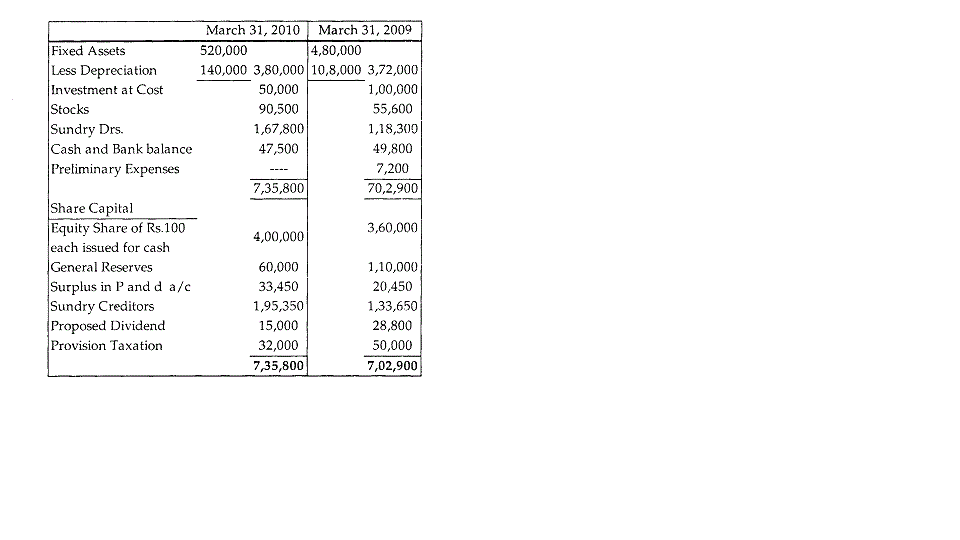
(a) The profit for the year (after providing for depreciation Rs 40,000 writing off preliminary expenses Rs. 7,200 and making provision for taxation Rs. 32,000) amounted to Rs. 38,000.
(b) The company sold during the year old machinery costing Rs. 9,000 for Rs. 3,000.
The accumulated depreciation on this machine was Rs. 8,000.
(c) A portion of the company's investment became worthless and was written off to general reserve. The cost of such investments was Rs. 50,000.
(d) During the year the company paid an interim dividend of Rs. 10,000 and the directors have recommended a final dividend of Rs. 15,000 for the year 2008-09
You are required to :
- (i)prepare a statement of sources
- (ii)and application of funds, and prepare a schedule of working capital changes.
Ms-4 Dec 2007
MS-4 Dec, 2007
MS-4 : ACCOUNTING AND FINANCE FOR MANAGERS
l. (a) What dq you understand by Accounting Standards ? How do they differ from Accounting Concepts ? Why should the accounting practices be standardised ?
(b) Why are the fixed assets shown at their book value rather than their market value, even if the latter has appreciated significantly ? Give reasons.
2. (a) How would Explain the you compute the cost of goods sold ? Explain two methods of inventory valuation
(b) What is depreciation and what is the rationale behind making a provision for depreciation in the process of matchlng income and expenses ?
3. What do you understand by Zero Base Budgeting ? How does a Zero Base Budget differ from a Flexible Budget ? Discuss the steps involved in Zero Base Budgeting.
4. Distinguish between :
(a) Accounting Rate of Return and Internal Rate of Return
(b) Profitability Index and Profitability Ratios
(c) Bonus Shares and Rights Shares
(d) Earnings yield and Dividend yield
5. A manufacturing company produces and sells products P; Q and R. It has an available machine hour capacity of one lakh hours, interchangeable among the 'three products. Presently the company produces and sells 20,000 units of P and 15,000 units each of Q and R. The unit Selling Price of the three products P, Q and R is Rs. 25, Rs. 32 and Rs. 42 respectively. With this price structure and the aforesaid sales-mix, the company is incurring loss. The total expenditure exclusive of fixed charjes (presently Rs. 5 per unit) is Rs. 13.75 lakhs. The'unit cost ratio amongst the three products P, Q and R is 4 : 6 : 7.
Since the company desires to improve its profitability without changing its cost and price structures, it has been considering-the following three mixes so as to be
Within its total available capacity :
|
Products Mix1 Mix 2 Mix 3 |
|
P 25000 20000 30000 Q 15000 12000 5000 R 10000 1 8000 15000 |
You are required to compute the quantum of loss now incurred and advise the most profitable mix which could be considered by the company.
6. Comment upon the following statements giving appropriate reasons :
(a) Higher net profit margin higher rate of return on investments
(b) EBIT-EPS analysis is an the capital structure. need not necessarily lead to
investment. important tool for designing the capital structure
(c) Cost of retained earnings is lower than the cost of equity.
(d) Many reasons account for direct material variances
- "The conventional break-even analysis is based on a number of assumptions." Explain and illustrate the concept of break-even analysis and justify the above statement.
8. The following three years information is available ior XYZ Ltd. for
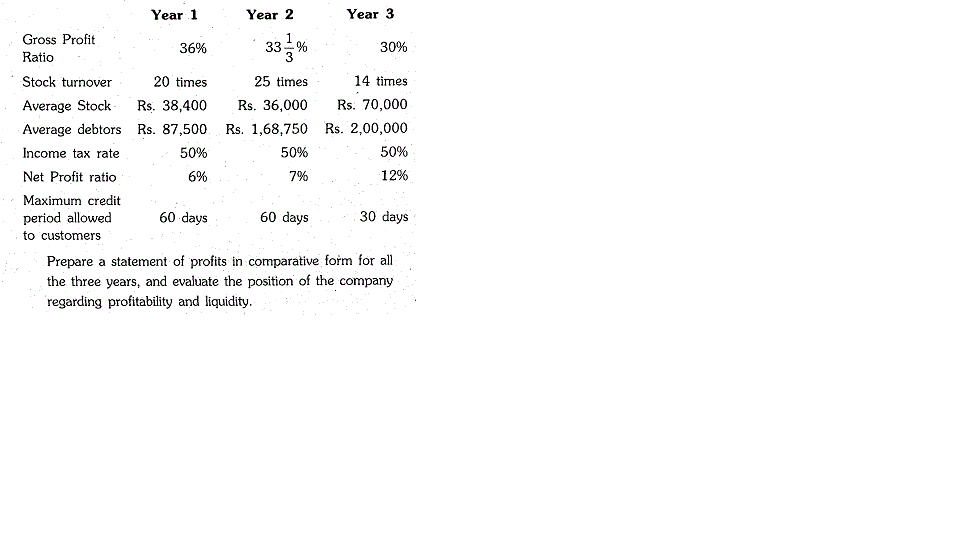
MS-4 DEC 2008
MS-4 Dec, 2008
MS-4 : ACCOUNTING AND FINANCE FOR MANAGERS
l. (a) Explain the Money Measurement Concept and the Accrual Concept. What are the limitations of the former concept. Explain.
(b) What do you understand by Accounting Standards ? Why are they necessary ? Explain with examples.
2. (a) Explain First-In First-Out and Last-In First-Out Methods of Inventory Valuation. In an inflationary situation, which method will give higher valuation of the inventory, other things remaining the same ? Explain.
(b) what do you understand by Capitalisation of earnings ? How is the value of a firm ascertained with the help of its earnings. Explain with an example
3. what do you understand by Composite Cost of Capital ? How is it computed ? Explain with an example. How would you support the statement that debt becomes more expensive after a certain point is reached ? Explain.
4. Distinguish between
(a) Preference Shares and Bonus Shares.
(b) Earnings Yield and Dividend Yield.
(c) Sales Price Variance and Sales Volume Variance.
(d) Shut Down Costs and Sunk Costs.
5. The summarised result of the operations of a company for the first year of its existence is glven below:
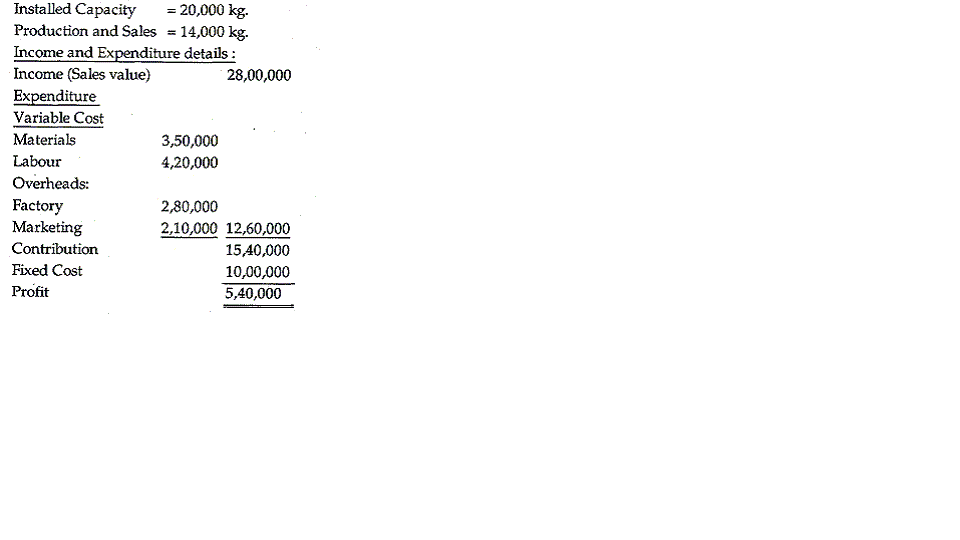
6.What is meant by Net Present Value ? Why is Profitability Index considered useful ? Discuss the Iimitations of Investment Appraisal Techniques.
7.Explain fully the following statements :
(a) Higher profit margins need not necessarily lead to higher rate of return on investement.
(b) Actual performance can be compared with the budget performance with the help of three ratios.
(c) A high operating leverage is not always desirable.
(d) Dividend, Investment and Financing decisions are inter-dependent
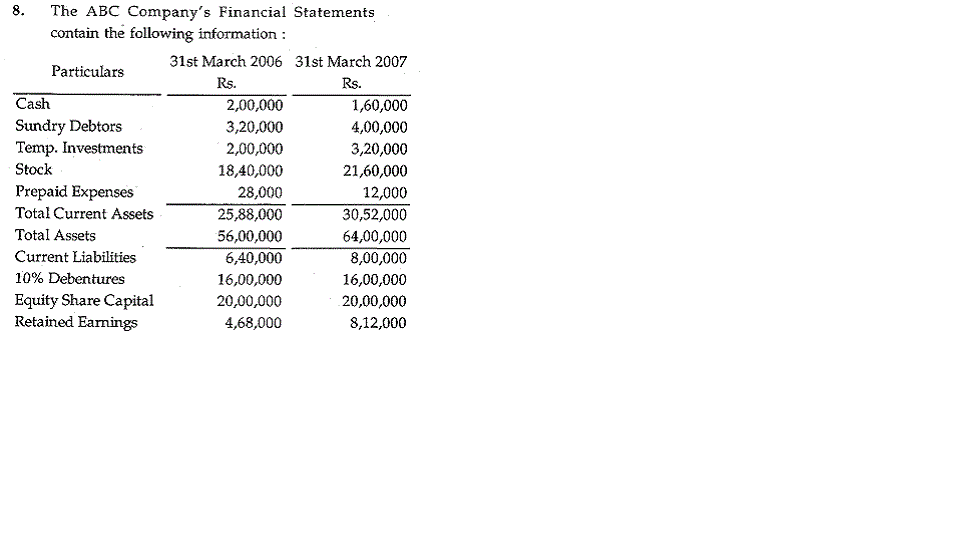
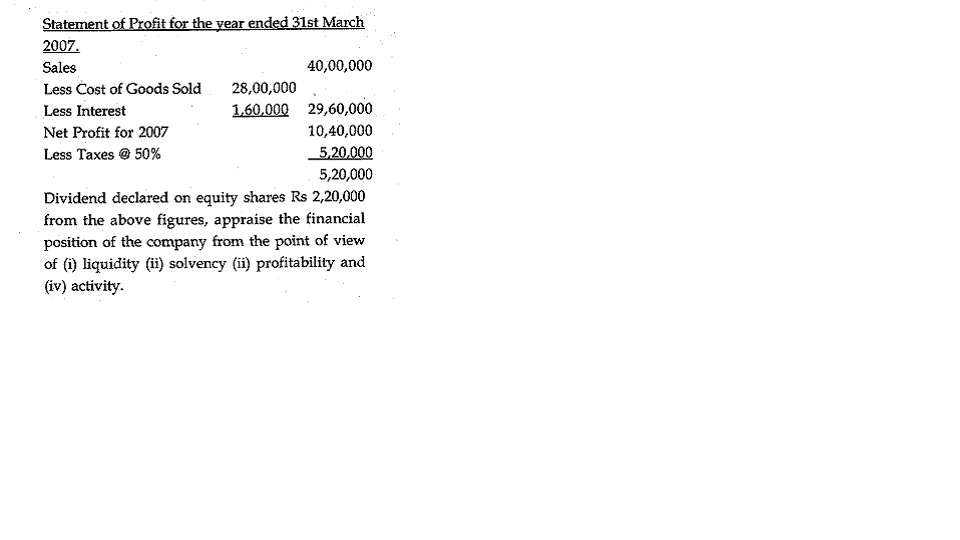
Ms-4 Dec 2009
MS-4 Dec, 2009
MS-4 : ACCOUNTING AND FINANCE FOR MANAGERS
1. (a) What do you understand by Internal Audit ? How do the functions of an internal auditor differ from that of External Auditor ?
(b) Explain the consistency concept and Accrual Concept of Accounting. How is the Accrual Concept adhered to while preparing the final accounts of a company ?
2. (a) What are intangible assets of a firm ? Why are they shown in the Balance Sheet ? What is meant by amortisation of such assets ? Give reason for the same.
(b) What do you understand by Appropriation of profit of a company ? How are the profits appropriated ? How will the profits to be appropriated, affected, if the company issues debentures, instead of equity shares to finance its activities ? Discuss how ?
3. Distinguish between :
a) FIFO and LIFO methods of Inventory valuation.
b) Rights Shares and Bonus Shares
(c) Direct Material Price Variance and Direct Material Usage Variance
(d) Imputed Costs and Opportunity Costs.
4. What do you understand by Break-even analysis ? Discuss the assumptions underlying the break-even analysis. How do these assumptions make the break-even analysis unrealistic ? Explain and prepare a Break-even chart assuming relevant figures.
5. (a) What do you understand by Flexible Budget ? How does it differ from a Fixed Budget ? Explain its utility to a business organisation.
(b) What do you mean by Control Ratios ? Explain the three important control ratios and discuss their significance.
6. Explain fully the following statements :
a) Operating cycle plays a decisive role in estimating the working capital requirement
of a firm.
b) As there is no explicit cost of retained earnings, they are free of cost.
c) Depreciation acts as a tax shield
d) An investor in shares considers not only its E.P.S. but also P.E. ratio.
7. A company, manufacturing a consumer product and marketing through its network of 400 depots all over the country, is considering closing down the depots and resorting to dealership arrangement. The total turnover of the company is Rs. 200 crore per annum. Average turnover, costs etc in respect of a depot is given below :
Average Turnover Rs. 50 lakh
Average Inventory Rs. 5 lakh
Administration Expenses Rs. 50,000 p.a
Staff Salary Rs. 80,000 p.a
The inventory carrying cost is 16% p.a., which is the rate for working capital finance. Marketing through dealers would involve engaging dealers for each area. The dealers will assure a minimum sale for each area. This would result in increasing the capacity utilisation from 75% as at present to 90%. The Company's P/V Ratio at present is 10% and the Break even point is at 50%of the capacity. Current profit is Rs. 150 lakh. Marketing through dealers would involve payment of a commission of 5% on sales, but 50% of the existing Depot Staff will have to be absorbed in the company. Dealers will deposit Rs. 5 crore with the company on which interest at 12% p.a. will be paid. You are required
- a)to work out the impact on profitability of the company by accepting the proposal as above, and
- b)to give your reaction if the commission to dealers is reduced to 4% on sales.
8. You have the following information on the performance of Premier Co. Ltd. and also the industry averages :
a) Determine the indicated ratios for the Premier Co. Ltd., and
b) Indicate the company's strengths and weakness as shown by your analysis.
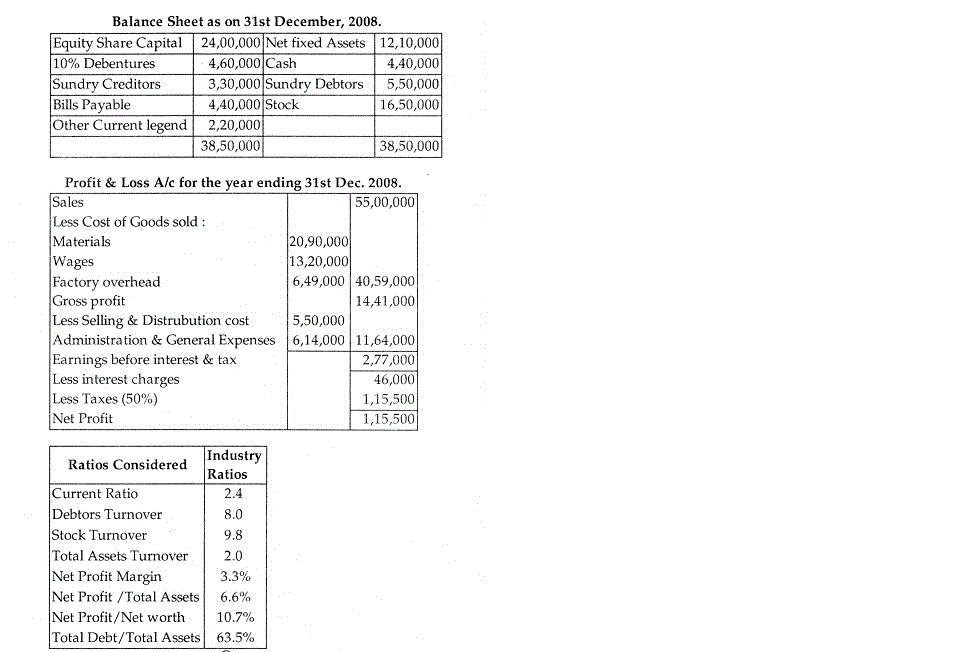
Ms-4 Dec 2010
MS-4 Dec, 2010
MS-4 : ACCOUNTING AND FINANCE FOR MANAGERS
Ms-4 Dec 2011
MS-4 Dec, 2011
MS-4 : ACCOUNTING AND FINANCE FOR MANAGERS
1. (a) How does an accountant follow the principle "anticipate no profit, provide for all losses" ? On which accounting concept is this based ? Explain it and discuss its significance.
(b) Distinguish between Financial Accounting and Management Accounting. What is the most important role of a Management Accountant in a business organisation ? Discuss.
2. (a) Distinguish between revenue expenditure and Capital expenditure. How are they treated while preparing the final accounts ? If by mistake the accountant of a firm treats a capital expenditure as revenue expenditure, how will it affect the final accounts of the' firm ? Give an example.
(b) Why is depreciation charged ? Explain the two methods of charging depreciation. In
which method the value of the asset is reduced to zero earlier ? Which one is more rational ? Explain why ?
3. "Financial Leverage is one of the important considerations in planning the capital structure of a company." Explain this statement giving an example. Briefly describe the other factors which are also considered while planning the Capital structure.
4. Distinguish between :
(a) Profit maximisation and Wealth maximisation goals.
(b) Accounting Rate of Return and Internal Rate of Return.
(c) Operating Cash flows and Financial cash flows.
(d) Direct Labour Rate Variance and Direct Labour Efficiency Variance.
5. Explain fully the following statements :
(a) "Break - even Analysis is not without limitations".
(b) "Lenders prefer high interest coverage ratio but a low debt-equity ratio".
(c) "Weighted average cost of capital would always be higher, if market value weights are used."
(d) Zero - based budgeting is a better alternative to traditional method of budgeting.
6. (a) "Sales Budget forms the basis on which all other budgets are built ." Explain. What factors are taken into consideration while preparing the sales budget ? Discuss.
(b) What is Rolling Budget ? How does it differ from flexible Budget ? What purposes
do these budgets serve ? Explain.
7. India Cables Ltd. is manufacturing a special type of cable used by electricity under takings the company is currently working at 80% capacity level. Data on annual sales and costs are as follows:
Sales Rs. 1,200 lakhs
Direct materials Rs. 560 lakhs
Direct Labour Rs. 240 lakhs
Factory overheads Rs. 180 lakhs
(80% fixed)
Selling, distribution and
Administration expenses
Rs 100 lakhs
(60% variable)
The company has just received an export order which requires utilisation of 40% of the plant capacity. The order can not be split and has to be executed in one lot as quickly as possible. The price offered is 10% lower than the current domestic price. Further, it will be necessary to spend 10% more on variable selling distribution and administration expenses because of the special type of export packing required. The company is considering the following options.
(a) reject the export order and carry on with the domestic sales.
(b) accept the export order and allow the domestic sales to fall to the extent required.
(c) Create additional plant capacity by installing new machinery which will result
in increase of fixed costs by Rs. 20 lakhs per annum.
Evaluate each of these options and suggest the best course of action for the company, assuming that the export order will continue in future years also.
8. From the following details furnished by Global Traders for the year ended March 31,2010 prepare its Balance Sheet as on that date :
Current Ratio 1.75
Quick Ratio 1.25
Gross Profit Ratio 25%
Reserves and surplus : capital 0.2
Stock Turnover 9
(cost of sales : closing stock)
Average collection period of 11/2 months
credit sales
Cost of sales : Fixed Assets 1.2
Debt : Equity Ratio 0.6
Fixed Assets : Net worth 1.25
The firm sells its products only on credit, credit sales for the year ended March 31,2010 amounted to Rs. 120 lakhs.
